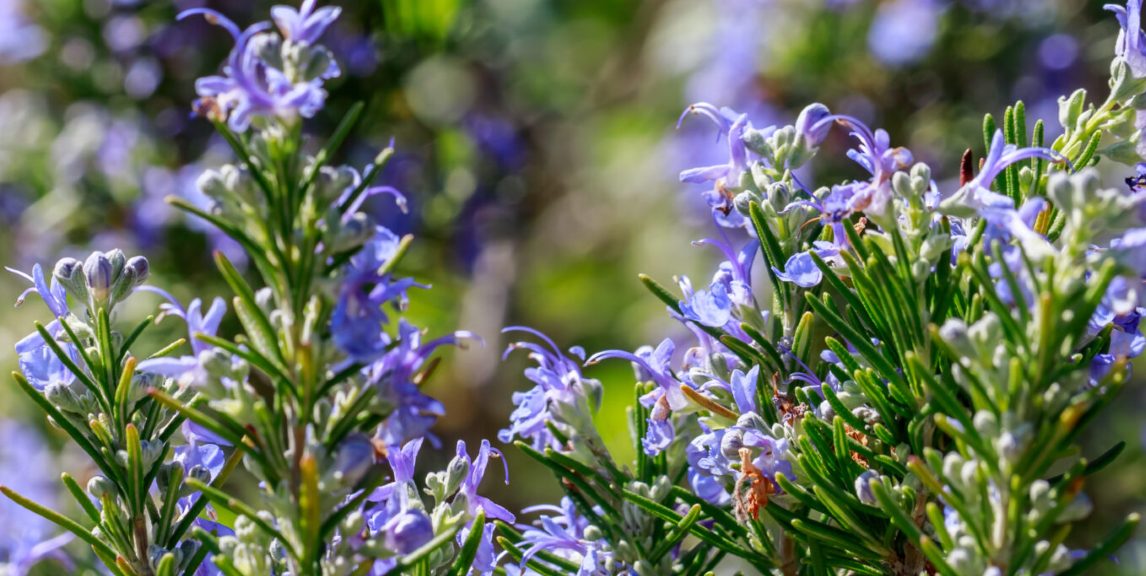
1. Introduction
Rosemary, scientifically known as Rosmarinus officinalis (now reclassified as Salvia rosmarinus), is a fragrant evergreen herb native to the Mediterranean region. With its needle-like leaves and delicate blue flowers, rosemary has been cherished for centuries not only for its culinary uses but also for its medicinal and symbolic significance. Often referred to as the “herb of remembrance,” rosemary has played a role in cultural rituals, traditional medicine, and modern wellness practices.
2. Where Does Rosemary Grow?
Rosemary thrives in warm, sunny climates and is native to the Mediterranean basin, including countries like Spain, Italy, Greece, and Morocco. It prefers well-drained, sandy soils and is highly drought-resistant, making it a popular plant in gardens worldwide. Today, rosemary is cultivated in many regions, including:
- Europe: Widely grown in the Mediterranean and temperate zones.
- North America: Commonly found in California and other warm states.
- Australia and South Africa: Adapted well to similar climates.
- Home gardens: Easy to grow in pots or herb gardens, even in cooler climates.
3. Botanical Characteristics
- Appearance: Rosemary is an evergreen shrub with woody stems, needle-like leaves, and small blue, purple, or white flowers.
- Growth habits: It can grow up to 1.5 meters tall and spreads widely if not pruned.
- Harvesting: The best time to harvest rosemary is in the morning when the essential oils are most concentrated. It can be used fresh or dried for long-term storage.
4. Historical and Cultural Significance
Rosemary has a rich history dating back to ancient civilizations:
- Ancient Egypt: Used in burial rituals and as incense.
- Ancient Greece and Rome: Symbolized memory and loyalty; students wore herb wreaths to improve concentration.
- Medieval Europe: Believed to ward off evil spirits and protect against the plague.
- Modern symbolism: Often used in weddings, funerals, and remembrance ceremonies.
5. Medicinal Properties of Rosemary
Rosemary is renowned for its therapeutic benefits, supported by both traditional use and modern science. Below are its key medicinal properties:
5.1 Cognitive Health and Memory Enhancement
- Rosemary has been shown to improve memory, focus, and mental clarity.
- The compound 1,8-cineole in rosemary essential oil may enhance brain function and protect against neurodegenerative diseases like Alzheimer’s.
5.2 Anti-Inflammatory and Pain Relief
- Rosemary contains rosmarinic acid and carnosic acid, which have potent anti-inflammatory effects.
- It is used to relieve muscle pain, arthritis, and headaches.
5.3 Digestive Support
- Stimulates bile production, aiding digestion and relieving bloating, gas, and indigestion.
- It can also act as a mild laxative.
5.4 Antimicrobial and Antifungal Properties
- The essential oil is effective against bacteria like E. coli and fungi like Candida albicans.
- It is often used in natural disinfectants and skincare products.
5.5 Antioxidant Benefits
- Is rich in antioxidants, which combat free radicals and reduce oxidative stress.
- This makes it beneficial for skin health, slowing aging, and preventing chronic diseases.
5.6 Hair and Scalp Health
- Oil stimulates blood circulation in the scalp, promoting hair growth and reducing dandruff.
- It is a natural remedy for alopecia and thinning hair.
6. Cosmetic and Skincare Applications
- Anti-aging: antioxidants help reduce wrinkles and improve skin elasticity.
- Acne treatment: Its antimicrobial properties make it effective against acne-causing bacteria.
- Aromatherapy: Essential oil is used to reduce stress, boost mood, and enhance mental clarity.
- Hair growth support: Stimulates hair follicles, promoting stronger and healthier hair growth, making it a popular ingredient in hair growth oil.
- Application in Nanorev Products: Rosemary is a key ingredient in Rosemary oil hair growth, where its stimulating properties promote hair growth and improve scalp health. It can also be added to creams and ointments due to its anti-inflammatory and antioxidant properties.
7. Culinary Uses
- Flavor profile: Hhas a pine-like aroma and a slightly bitter, woody taste.
- Common dishes: Used to flavor roasted meats, soups, stews, and bread.
- Infusions: Tea or infused oils are popular for their health benefits.
8. Safety and Precautions
- Dosage: Use rosemary in moderation; excessive consumption may cause nausea or vomiting.
- Allergies: Some individuals may experience skin irritation from rosemary oil.
- Contraindications: Avoid during pregnancy or if you have epilepsy, as it may stimulate the nervous system.
9. DIY Recipes with Rosemary
- Hair Rinse: Boil leaves in water, cool, and use as a final rinse after shampooing.
- Infused Oil: Combine fresh with olive oil and let it sit for 2-3 weeks. Use for cooking or skincare.
- Tea: Steep fresh or dried rosemary in hot water for 5-10 minutes. Add honey for sweetness.
Conclusion
Rosemary is a versatile herb with a rich history and numerous health benefits. From enhancing memory to improving skin and hair health, this Mediterranean gem deserves a place in your daily routine. Whether used in cooking, skincare, or natural remedies, rosemary is a testament to the power of nature.


